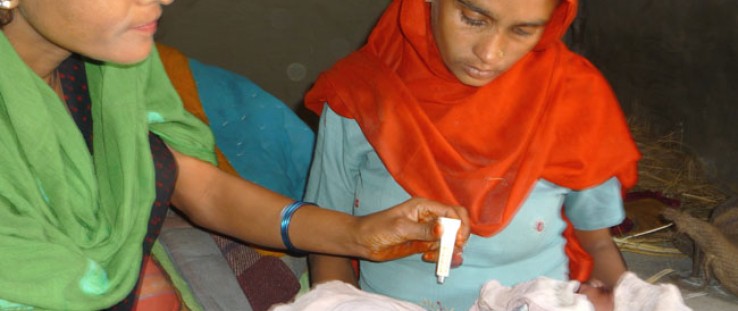 A community health volunteer applies chlorhexidine to the umbilical cord of a newborn delivered at home in Banke district.
Nima Gupta, Nepal Family Health Association
A community health volunteer applies chlorhexidine to the umbilical cord of a newborn delivered at home in Banke district.
Nima Gupta, Nepal Family Health Association
 A community health volunteer applies chlorhexidine to the umbilical cord of a newborn delivered at home in Banke district.
Nima Gupta, Nepal Family Health Association
A community health volunteer applies chlorhexidine to the umbilical cord of a newborn delivered at home in Banke district.
Nima Gupta, Nepal Family Health Association
With one in 19 Nepalese children dying before their fifth birthdays—and half that number dying before they even complete their first 28 days of life—finding successful interventions for newborn care has been critical. Today, the 50,000-strong government health worker cadre known as Female Community Health Volunteers (FCHVs) is helping turn the tide, saving newborns from potentially life-threatening infections through the application of a simple intervention—chlorhexidine.
Chlorhexidine, which can be administered topically as a gel or liquid, has been used extensively in health-care settings for decades as a pre‐surgical and an oral antiseptic at varying concentrations, and it is widely available globally. Since the 1970s, mothers and newborns in developed countries have received chlorhexidine-based cleansing solutions to reduce the development and transmission of infections. Because evidence was limited, however, that these approaches were valuable in reducing newborn umbilical cord infections, their use did not gain widespread acceptance.
The World Health Organization (WHO), in the late 1990s, suggested more studies were needed to assess the effectiveness of antiseptic medications for newborn cord care, particularly in high-risk settings. Taking up that charge, USAID has been at the forefront in supporting research to demonstrate that a simple 4-percent chlorhexidine solution, when applied to the umbilical cord after birth, can prevent newborn infections and reduce newborn deaths.
The Agency, along with the National Institutes of Health and the Gates Foundation, funded the first completed study of neonatal and umbilical cord care with chlorhexidine in Nepal with over 15,000 infants. The results, published in 2006, found that use of chlorhexidine on the umbilical cord significantly reduces local cord infections and overall neonatal mortality.
Specifically, the results showed that, when applied to the umbilical cord stump on the day of birth and then daily over the first week of life, a 4-percent solution of chlorhexidine prevented infection and reduced neonatal mortality by around 24 percent more than care with soap and water or the standard dry cord care (not applying anything to the cord but instead keeping it clean and dry until the stump falls off).
Sulochana Jaisi, a new mother whose baby received the chlorhexidine treatment, explains: “Before the [chlorhexidine] program was initiated, we used to apply ash, oil and turmeric on umbilical cords …. We like it because we don’t need any help to apply the [gel], we can do it on our own.”
Local acceptance and ease of use are important factors in determining the effectiveness of any treatment; in Nepal, chlorhexidine has received encouraging marks in both. Other studies have shown how easy chlorhexidine is to administer by front-line health workers, a significant advantage in a country where three-fourths of babies are born at home.
Piloting Success
Swayed by the results of USAID-backed studies, Nepal’s Health Ministry approved a USAID-funded pilot program in four districts. In Banke, Bajhang, Parsa and Jumla, community health workers were trained to educate mothers and caregivers about the dangers of cord infection and introduced the umbilical ointment into the routine newborn care practice, applying it to the cord immediately after cutting or explaining how it is done.
Sita Shing, who has been a health worker in her community for over 25 years, uses a doll to show expectant mothers how to apply the solution. The doll is dressed in a traditional baby cloth called Bhoto-Suruwal to teach mothers the importance of avoiding hypothermia.
As part of the effort to scale up this intervention, this year USAID and its implementing partners negotiated with local pharmaceutical companies to procure chlorhexidine in bulk for less than $0.15 per tube. The 4-percent chlorhexidine product was named Kawach, the Sanscrit word for shield, following informal polling amongst Nepali health professionals.
An 18-month pilot period to promote chlorhexidine proved successful at reaching a large number of Nepali mothers and families.
“[This] is a very important program because, after its implementation, the number of infected umbilical cord cases in my facility declined. I have also seen that fewer babies are dying in my VDC [village development committee],” explains Birendra Ghale, a health worker in charge of this peripheral-level health facility in Banke, which lies at the base of the Himalayas, bordering India. “In addition, traditional practices of applying different kinds of substances, which are often harmful, have been replaced.”
A Regional Success
Beginning in 2007, two additional randomized controlled trials of chlorhexidine efficacy were launched in Bangladesh and Pakistan. The USAID-funded work, in collaboration with the Saving Newborn Lives program, found that chlorhexidine cord cleansing reduced the risk of mortality in newborns by between 20 percent and 38 percent, respectively. In 2010, the neonatal mortality rate in Bangladesh was 31 per 1,000 births; in Pakistan, the rate was 43 per 1,000 births.
In South Asia, where newborn infections range from 12 percent to 26 percent, the widespread use of chlorhexidine could potentially save 200,000 newborn lives.
Following the success of its own pilots, in 2011, the Nepalese Government announced it will scale up the use of chlorhexidine nationwide. Says Dr. Naresh Pratap KC, director of the Health Ministry’s Family Health Division: “The Government of Nepal is proud to have implemented the intervention from the pilot stage through scale-up… and I believe that this intervention will help us achieve [Millennium Development Goal] 4 by reducing neonatal deaths in Nepal.”
John Snow Inc. (JSI), with a grant from the USAID-sponsored Saving Lives at Birth Grand Challenge, is working within the ministry to accelerate this scale-up with the goal of mainstreaming chlorhexidine in all districts nationwide. JSI also will work to ensure the product’s availability, as well as continue to increase awareness and delivery of the intervention.
The newly published research from Pakistan and Bangladesh has increased national, regional and global interest in this intervention. Additional studies are currently underway in Tanzania and Zambia to test its effectiveness in those settings.
Says Saul Morris, senior program officer at the Bill & Melinda Gates Foundation: “The Bill & Melinda Gates Foundation decided to fund two trials in Africa because we wanted to confirm the exciting results emerging from South Asia. In sub-Saharan Africa, there are some differences in the etiology [cause] of neonatal sepsis as compared to South Asia and overall rates of bacterial colonization of the umbilical stump are lower. We felt that these differences justified confirmation of value-for-money in these settings, and we also felt that involvement in local trials provided an important means of engaging African scientists and policymakers in a dialogue about the potential benefits of cord cleansing with chlorhexidine.”
Chlorhexidine also has been included in the ongoing U.N. Commission on Life-Saving Commodities for Women and Children, and USAID is supporting a WHO expert review of this new evidence. This could potentially lead to changes to its umbilical cord-care guidance.
Half a Million Preventable Deaths
An estimated one-third of the 3.5 million neonatal deaths that occur each year globally are due to preventable severe infections. A baby’s umbilical cord is a common entry point for bacteria to invade the surrounding tissue as well as the baby’s bloodstream. In both Asian and sub-Saharan African cultures, women often rub harmful substances such as mustard oil, ash or turmeric powder on the cord stump of newborns, believing that this may reduce infections. Studies have shown that mustard oil and other substances increase the risk of infection.
In its 1998 guidelines, the WHO recommends clean and dry umbilical cord care. However, it also says that: “In settings where the risk of bacterial infection is high, it may be prudent to apply an antiseptic to the cord per local preference.”
Chlorhexidine may just be that prudent solution the WHO had in mind. Experts now say that the little tube has the potential to reach large populations and avert an estimated 500,000 neonatal deaths per year.







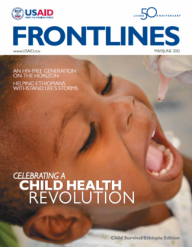

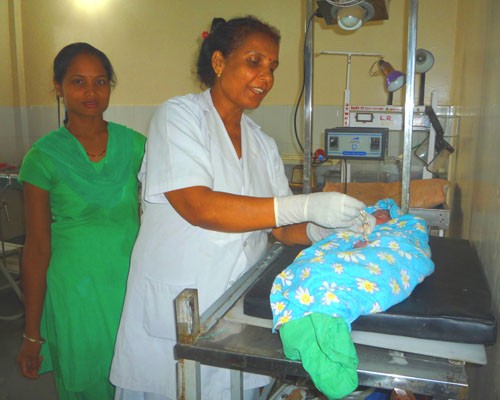
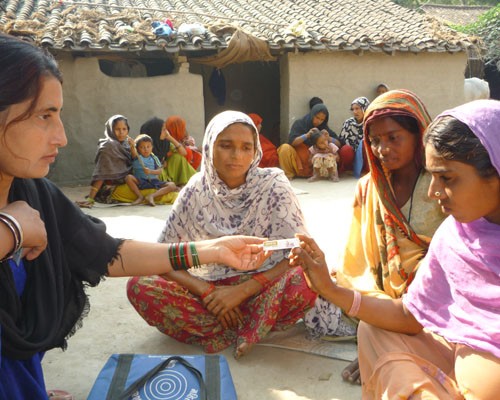
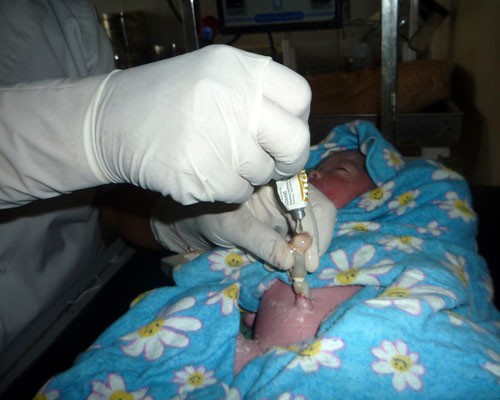
Comment
Make a general inquiry or suggest an improvement.